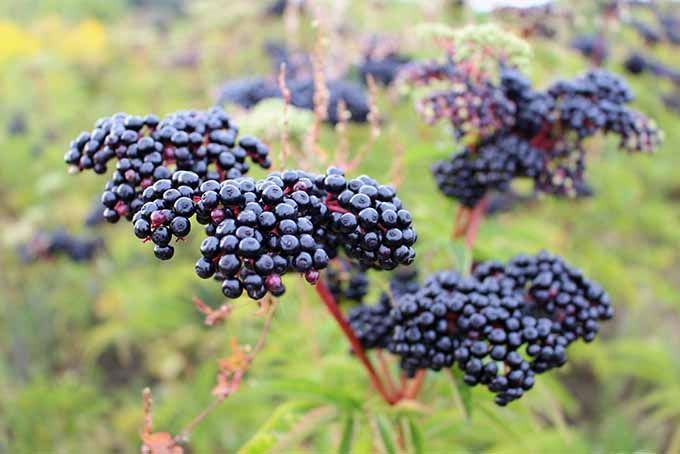Elderberry Fruit
Health Benefits of Elderberry Fruit
English Name: Elderberry Fruit
Latin Name: Sambucus
Type: Botanical
What is Elderberry Fruit?
Elderberry fruit are the dark purple berries that grow on American and European elderberry shrubs in late summer and early fall. The shrubs are deciduous but very hearty, withstanding harsh winters in North America and Canada without damage. The fragrant, umbrella-shaped flowers are also edible and are sometimes used to make an effervescent wine. They are also the basis of St. Germaine liqueur. The berries are so dark in color as to appear almost black, and they present in clusters not unlike grapes. A high concentration of anthocyanidins produce this rich color, and juice from the berries is commonly used as a coloring additive for food in the U.S. and Europe. Because the shrub grows quickly and is malleable to pruning, it is a desirable hedgerow in much of Europe. The strong, pliable branches have long been used to weave baskets, and the berries have traditionally been included in jams, jellies, juice and pies in many European cultures1.
How does Elderberry work?
Elderberries contain a remarkably high level of vitamin C — more than that of an orange — as well as vitamins A and B6 and the essential mineral iron. They are also rich in anti-oxidants, which help the body fight against many viruses and other invaders. The anthocyanidins that give the berries their rich color are a type of flavonoid that the USDA recognizes as being highly beneficial for supporting healthy cholesterol levels and overall cardiovascular health2. The berries must be cooked or otherwise processed before consuming, as raw berries, leaves and stems of the elderberry can be toxic3.
What are the benefits of Elderberry Fruit?
Because of its high concentration of vitamins and anti-oxidants, elderberry fruit has been used for centuries to treat a number of common ailments. Most notably, it can not only relieve some symptoms of the influenza virus, but it has been known to reduce the length of time the flu lasts, especially when combined with echinacea. It seems to affect the common cold in a similar way, relieving symptoms like nasal congestion while shortening the time the cold lingers. Elderberry fruit shows promise for limiting “bad” cholesterol without impeding “good” cholesterol, and it has proven effective in alleviating constipation. The fruit may also help keep oral conditions like gingivitis from worsening3.
Products Featuring Elderberry Fruit
For Humans:
InstaClear Sinus Relief™ for Sinus Comfort

Native Remedies recommends you consult your doctor before introducing new herbal products into your regimen. Always ensure you are buying high-quality, laboratory-tested supplements from a reputable supplier. At Native Remedies, we back all our products with a 100 percent money-back guarantee. If you’re not happy with your purchase after trying it for 30 days, simply send it back for a refund. Here’s to your good health!
The content provided is for informational purposes only. It is not a substitute for professional medical advice. If you have a health condition, please consult a medical professional and do not use this information to self-diagnose or self-treat.
Resources:
[1] "Edible Landscaping - Edible of the Month: Elderberry." Light in the Rainforest - Garden.org. Accessed October 08, 2018. https://garden.org/learn/articles/view/4152/.
[2] Bhagwat, Seema, David Haytowitz, and Joanne Holden. "USDA Database for Flavonoid Content of Selected Foods." ARS User Files. September 2011. Accessed October 8, 2018. https://www.ars.usda.gov/ARSUserFiles/80400525/Data/Flav/Flav_R03.pdf.
[3] "Elderberry: Uses, Side Effects, Interactions, Dosage, and Warning." WebMD. Accessed October 08, 2018. https://www.webmd.com/vitamins/ai/ingredientmono-434/elderberry.
Reviewed by Master Herbalist, Mary Ellen Kosanke
